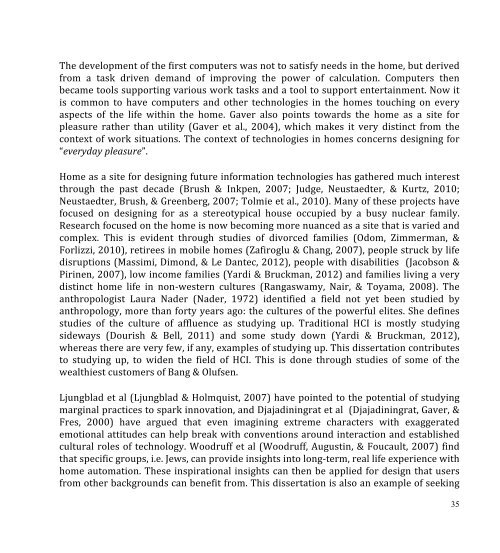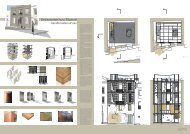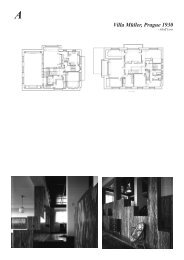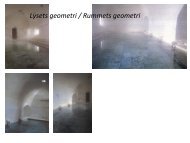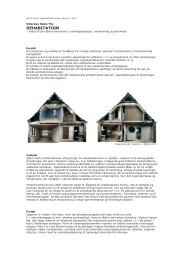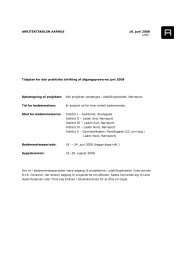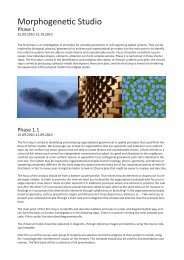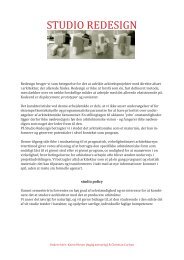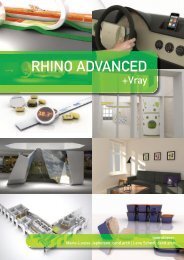-Tactics and Concepts for Highly Mobile People
-Tactics and Concepts for Highly Mobile People
-Tactics and Concepts for Highly Mobile People
Create successful ePaper yourself
Turn your PDF publications into a flip-book with our unique Google optimized e-Paper software.
The development of the first computers was not to satisfy needs in the home, but derived<br />
from a task driven dem<strong>and</strong> of improving the power of calculation. Computers then<br />
became tools supporting various work tasks <strong>and</strong> a tool to support entertainment. Now it<br />
is common to have computers <strong>and</strong> other technologies in the homes touching on every<br />
aspects of the life within the home. Gaver also points towards the home as a site <strong>for</strong><br />
pleasure rather than utility (Gaver et al., 2004), which makes it very distinct from the<br />
context of work situations. The context of technologies in homes concerns designing <strong>for</strong><br />
“everyday pleasure”.<br />
Home as a site <strong>for</strong> designing future in<strong>for</strong>mation technologies has gathered much interest<br />
through the past decade (Brush & Inkpen, 2007; Judge, Neustaedter, & Kurtz, 2010;<br />
Neustaedter, Brush, & Greenberg, 2007; Tolmie et al., 2010). Many of these projects have<br />
focused on designing <strong>for</strong> as a stereotypical house occupied by a busy nuclear family.<br />
Research focused on the home is now becoming more nuanced as a site that is varied <strong>and</strong><br />
complex. This is evident through studies of divorced families (Odom, Zimmerman, &<br />
Forlizzi, 2010), retirees in mobile homes (Zafiroglu & Chang, 2007), people struck by life<br />
disruptions (Massimi, Dimond, & Le Dantec, 2012), people with disabilities (Jacobson &<br />
Pirinen, 2007), low income families (Yardi & Bruckman, 2012) <strong>and</strong> families living a very<br />
distinct home life in non-‐western cultures (Rangaswamy, Nair, & Toyama, 2008). The<br />
anthropologist Laura Nader (Nader, 1972) identified a field not yet been studied by<br />
anthropology, more than <strong>for</strong>ty years ago: the cultures of the powerful elites. She defines<br />
studies of the culture of affluence as studying up. Traditional HCI is mostly studying<br />
sideways (Dourish & Bell, 2011) <strong>and</strong> some study down (Yardi & Bruckman, 2012),<br />
whereas there are very few, if any, examples of studying up. This dissertation contributes<br />
to studying up, to widen the field of HCI. This is done through studies of some of the<br />
wealthiest customers of Bang & Olufsen.<br />
Ljungblad et al (Ljungblad & Holmquist, 2007) have pointed to the potential of studying<br />
marginal practices to spark innovation, <strong>and</strong> Djajadiningrat et al (Djajadiningrat, Gaver, &<br />
Fres, 2000) have argued that even imagining extreme characters with exaggerated<br />
emotional attitudes can help break with conventions around interaction <strong>and</strong> established<br />
cultural roles of technology. Woodruff et al (Woodruff, Augustin, & Foucault, 2007) find<br />
that specific groups, i.e. Jews, can provide insights into long-‐term, real life experience with<br />
home automation. These inspirational insights can then be applied <strong>for</strong> design that users<br />
from other backgrounds can benefit from. This dissertation is also an example of seeking<br />
35


